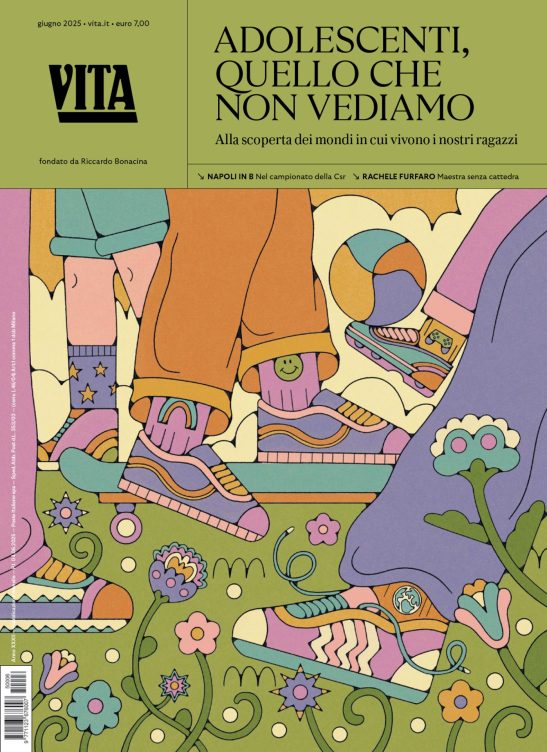Non profit
Playing for a new life
Interview with Mel Young, President of the Homeless World Cup, on-going from September 6-13 in Milan
di Staff

Milan. Two teams, a football. Just a few fans, very little cheering.
Apocalyptic scene in San Siro, the stadium that acts as temple of football in this country where the sport has almost muted into a religion?
But no: we are at the Civic Arena in Milan, at the Sempione Park, which is hosting the seventh edition of the Homeless World Cup, from 6 to 13 September.
Despite the fact that this free event was very well covered by the media, the participation of Italian fans to this tournament is scarce.
And Mel Young – President of the Homeless World Cup, as well as co-founder of the Scottish version of the Big Issue magazine and of the New Consumer Magazine, and founder and honorary President of the International Network of Street Newspapers – is surprised. As a real football fan (his favourite team is Hibernian, based in Edinburgh), Young expected that the Italian football supporters, those who follow the Italian league on Sundays, would also go and watch this competition.
“Because this is a high-level football tournament,” he explains. “This year in Italy we are even seeing the best football ever in this tournament. Come watch. It’s really exciting”.
How was the idea of a Homeless World Cup born?
The Homeless World Cup was invented by myself and a colleague of mine in 2001. We wanted to use football as a tool for eliminating social exclusion, encouraging homeless people to change their lives. Being a part of a team and taking part in the tournament helps them to concentrate and be healthy, and for some even to abandon the use of drugs and alcohol. Hearing the fans cheering helps them also psychologically. It is a fantastic experience for them. The first edition was held in 2003 in Austria, and since then once a year.
What are the concrete aims of this initiative?
Using sport as a tool for change. As far as homeless people are concerned, the key aim of this tournament is to involve them in football to improve their lives: the players often gain confidence in themselves, they build trust and try to change their previous lives into new ones. At the end of this process (players are allowed to take part to the competition just once), many homeless people find a job and a house. Many become coaches. As far as the public is concerned, the Homeless World Cup’s aim is to entertain: it is a fantastic tournament, and it is very exciting watching the football matches. Moreover, the event seeks to raise awareness among the citizens, the authorities and the media on the problem of the homeless people and to change stereotypes and prejudices.
Who can take part in this competition?
The only criterion is to be homeless. During the year, in different countries all over the world, organizations that work with homeless people try to encourage and involve them in playing football. Then, when the Homeless World Cup approaches, these organizations select the participants who will take part in the international tournament.
How many teams participate in the event?
In 2003 there were 18 football teams from all over the world. This year in Milan the teams are 48.
What about the Women Cup?
The Women Cup is an extended Homeless World Cup. We did it as an experiment last year in Melbourne, and it was a real success. Unfortunately we have not had enough time to organize it this year. Which is why in Milan teams are made up mainly by men, but there are also some women. We will organize the extended Women Cup again next year in Brazil..
Why football?
Because it is simple to learn, and it is easy to involve people in this sport. Moreover, football can be played everywhere: in a stadium as well as on a street. And it is a team sport that can be played by 2 as well as 20 players aside. Any sport could work, but football works best.
How is this initiative financed?
There are two sources of financing: private donations and sponsors.
The former, on which we focus, is used directly in different countries to set up and raise awareness on local football projects and to support players, guaranteeing accessories – the actual footballs for instance – and infrastructures, but also running contacts with potential employers. The aim is to develop sustainable projects in every country in order to help homeless people change their lives through football.
Sponsors and city councils that host the event pay for the organization of the tournament itself. Among the main international sponsors are Uefa, Nike, Vodafone.
Where was this initiative been held in the past and where will it take place in the future?
The first edition of the cup was held in Graz, Austria, in 2003. The second edition in Gothenburg, Sweden, in 2004; in 2005 in Edinburgh, Scotland; in 2006 in Cape Town, South Africa; in Copenhagen, Denmark, in 2007; in 2008 in Melbourne, Australia, and in 2009 in Milan. Next year it will be hosted in the Brazilian city of Rio de Janeiro, in 2011 in Paris.
To see the whole schedule of the matches in Milan, visit the official website of the competition: www.homelessworldcup.org.
17 centesimi al giorno sono troppi?
Poco più di un euro a settimana, un caffè al bar o forse meno. 60 euro l’anno per tutti i contenuti di VITA, gli articoli online senza pubblicità, i magazine, le newsletter, i podcast, le infografiche e i libri digitali. Ma soprattutto per aiutarci a raccontare il sociale con sempre maggiore forza e incisività.
